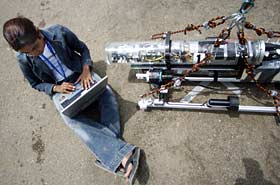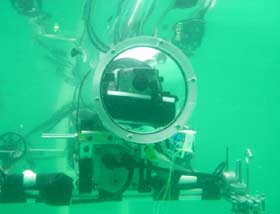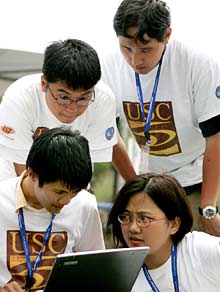Students show off underwater crafts at S.D. competition
By Elena Gaona
UNION-TRIBUNE STAFF WRITER
August 8, 2005
Underwater robots sputtered and stalled in murky water, but the 21
teams in yesterday's Autonomous Underwater Vehicle Competition advanced
by leagues.

DAVID BROOKS / Union-Tribune
Charmy Chhichhia, a first-year master's student
at the University of Southern California, made last-minute adjustments
to her team's underwater vehicle yesterday.
|
"It is truly the cream of the crop competing
here, and even if a small number of these people go into the field then
we're increasing the quality of the equipment," said Daryl Davidson,
executive director of the Virginia-based Association for Unmanned
Vehicle Systems International.
"The competition gets smarter every year."
The annual competition, held at the Space and
Naval Warfare Systems Center in Point Loma, is sponsored by the Office
of Naval Research and the Association for Unmanned Vehicle Systems
International. Organizers hope to inspire students to pursue careers
developing unmanned vehicles.
College teams from throughout the United States
and Canada competed, as well as one from India that plans to eventually
focus on tsunami monitoring. The only high school team was from from
Amador Valley High School in Alameda County.
Although $20,000 was at stake, bragging rights
were even more valuable to the college and high school students
competing to be the best underwater robot student team in the world.

DAVID BROOKS / Union-Tribune
USC's underwater craft made it through the gate,
but then it lost a ballast and surfaced, ending its run at the
Autonomous Underwater Vehicle Competition.
|
Organizers said the student's submarines were one step beyond the unmanned vehicle that rescued seven Russian sailors yesterday.
In the Bering Sea, an unmanned rescue vehicle
cut away at undersea material that had ensnared a mini-submarine. At
the competition, teams tried to make their submerged unmanned vehicles
operate on their own, without human-operated remote controls guiding
them.
"It's the next generation," said Steve Koepenick, a business development director at the Space and Naval Warfare Systems Center.
Unmanned submarines have been used to sweep for
mines in Iraq and monitor oil pipelines. The goal of unmanned vehicles
is to save time, money and human lives by getting machines to take the
role of humans.
"Part of the effort is to get the mammal out of the loop, away from anything dull and dangerous," Koepenick said.
The students did their best to advance the cause. The path, though, was fraught with underwater peril.

DAVID BROOKS / Union-Tribune
USC team members (clockwise from top left) Nick
Kiswanto, Harold Lim, Hannung Lin and Yit-Phang Khoo tried to establish
a connection with their vehicle. Many crafts stalled, and some couldn't
even get started, but participants still made progress in yesterday's
competition in Point Loma.
|
"It's a beauty," said University of Southern
California robotics team adviser Laurent Itti, as the university's
swift Beo Sub II took off.
The robot had been programmed to begin its operation when it saw a bumper sticker that read: "My Other Vehicle is Unmanned."
Then it passed through a gate effortlessly. Then it stalled.
Still, cheers erupted. No one expected more from
the sub because a cable had failed the day before and there wasn't time
to integrate new software.
Team member Hannung Lin put her hand over her heart at the thought of the cable problem, which she referred to as "the tragedy."
Each team had 15 minutes for its custom-built unmanned robotic sub to complete three tasks.
After getting through a gate, the first task was
to locate a floating strobe 10 feet under murky water. In the second,
subs followed a jagged line of orange pipes 16 feet and dropped markers
into gaps between the pipes. And finally, the subs followed a sonar
beep, then ascended through a circle directly above the sonar.
 |  | Advertisement | |
|
|
|
Few could complete all three tasks. Some didn't make it through the gate.
Even the team the competitors feared most – The
Orca Project from the Massachusetts Institute of Technology – had
issues. At one point, the sub followed a reflection of the sun off its
own body rather than diving for the beacon.
Still, MIT placed third.
The University of Florida was the surprise
first-place winner after seven tries. Following closely in second place
was Canada's Ecole de Technologie Superieure. Duke University took
fourth place.
 Elena Gaona: (760) 737-7575; elena.gaona@uniontrib.com Elena Gaona: (760) 737-7575; elena.gaona@uniontrib.com
|



